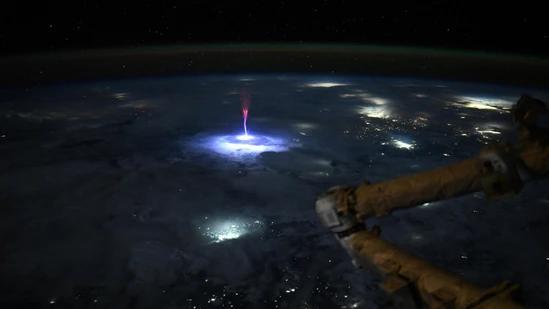
NASA Astronaut Captures Rare ‘Sprite’ Lightning Over US & Mexico
In a rare and breathtaking capture, NASA astronaut Nichole Ayers has shared a stunning photograph of a “sprite” lightning phenomenon from the International Space Station while orbiting above the United States and Mexico. The image showcases a brief burst of light, known as a Transient Luminous Event (TLE), which occurs above thunderstorms. This extraordinary sighting has sparked excitement among scientists, who can now use the photo to better understand the relationship between TLEs and thunderstorms.
Ayers, a NASA astronaut, captured the remarkable image while on a mission at the International Space Station. The photograph shows a vibrant, glowing sprite hovering above the clouds, surrounded by a dark, stormy sky. The image is a testament to the awe-inspiring beauty of the natural world and the incredible vantage point offered by the International Space Station.
The sprite, a type of TLE, is a rare and elusive atmospheric phenomenon. TLEs are brief, intense bursts of light that occur above thunderstorms, typically between 20-50 kilometers above the Earth’s surface. They are characterized by their bright, glowing appearance, which can range from soft, pulsing lights to intense, fiery explosions.
Scientists have long been fascinated by TLEs, but they remain poorly understood. The rare sighting of a sprite allows researchers to gain valuable insights into the relationship between TLEs and thunderstorms. By studying the behavior and characteristics of sprites, scientists can better comprehend the complex interactions between the atmosphere, lightning, and thunderstorms.
Ayers’ photograph provides a unique opportunity for scientists to analyze the sprite and its behavior. “Scientists can use these types of photos to better understand the relationship of TLEs to thunderstorms,” Ayers said in a statement. “It’s an incredible chance to study this rare phenomenon and learn more about our planet’s atmosphere.”
The capture of this rare lightning phenomenon is a testament to the incredible capabilities of the International Space Station and the astronauts who call it home. The station, which has been in operation since 1998, has provided scientists with a unique platform for conducting research and studying the Earth from a perspective that is impossible from the ground.
Ayers’ photograph is just the latest in a long line of remarkable captures from the International Space Station. The station has been used to study a wide range of phenomena, from the Earth’s weather patterns to the behavior of the ocean’s currents. Astronauts on the station have also captured stunning images of the Earth, including breathtaking sunrises and sunsets, as well as rare and unusual weather events.
The capture of this rare sprite lightning phenomenon is a reminder of the incredible beauty and complexity of the natural world. It also highlights the importance of continued investment in space exploration and research, which can provide valuable insights into the workings of our planet and the universe beyond.
In conclusion, NASA astronaut Nichole Ayers’ capture of a rare “sprite” lightning phenomenon over the United States and Mexico is a remarkable reminder of the incredible beauty and complexity of the natural world. The image provides scientists with a unique opportunity to study this rare phenomenon and learn more about the relationship between TLEs and thunderstorms. It is a testament to the incredible capabilities of the International Space Station and the astronauts who call it home, and serves as a reminder of the importance of continued investment in space exploration and research.






